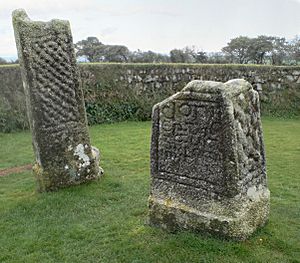King Doniert's Stone facts for kids
King Doniert's Stone (which is Menkov Donyerth Ruw in the Cornish language) is made up of two parts of a fancy stone cross from the 800s. You can find it near St Cleer in Bodmin Moor, Cornwall. People think the writing on the stone remembers Dungarth, who was the King of Cornwall and died around the year 875.
Contents
What is King Doniert's Stone?
The History of Stone Crosses
Christianity first came to Cornwall in the 400s. It was brought by monks from Wales and Ireland. These early missionaries likely put up wooden crosses. These crosses showed places where they had shared their faith. Over time, these spots became special. The wooden crosses were then replaced with stone ones.
What You See at the Site
The site has two pieces of granite crosses. They are from the 800s to 1000s. There is also an underground passage and a cross-shaped room below the crosses. People think this might be old tin workings. It could also be a small chapel.
The northern cross is called the "Doniert Stone." It is about 1.37 meters (4.5 feet) tall. It has cool patterns of intertwined lines on three sides. There is also an inscription in an old style of writing.
Understanding the Inscription
The inscription says doniert rogavit pro anima. This means "Doniert has asked [for this to be made] for his soul's sake." Experts believe this refers to a local ruler named "Dumgarth" or "Dwingarth." An old Welsh record, the Annales Cambriae, says he drowned around 875 AD. The stone also has a special slot and a base at the bottom.
The southern cross is sometimes called the "Other Half Stone." It is about 2.1 meters (6.9 feet) tall. It has intertwined patterns on its east side. It also has a broken slot at the top and a base at the bottom.
Exploring the Underground Chamber
Discoveries from Excavations
In 1849, a group called the Exeter Diocesan Architectural Society dug around the stones. They found a hidden room underneath them! Mr. Charles Spence wrote about what they found.
Workers first lifted the Doniert Stone. It weighed over two tons! Then they dug next to the other stone. About eight or nine feet down, they found a hole. This led to a cross-shaped room. It was about 18 feet long from east to west and 16 feet from north to south. The room was about four feet wide. Its sides were straight, and the roof was rounded. Everything was smoothed with tools.
The miners who helped with the digging said it looked like "old workings." This means they thought it was an ancient mine.
The Chamber's Layout
The underground room starts as a passage about 8 meters (26 feet) southeast of the crosses. It then turns into a tunnel. Finally, it opens into the cross-shaped room right under the crosses. We don't know for sure how this underground room connects to the crosses above.
Visiting King Doniert's Stone
The Cornwall Heritage Trust looks after this site. They do this for English Heritage. You can park your car in a special area next to the site. It's free to visit, and you can go anytime during daylight hours.


